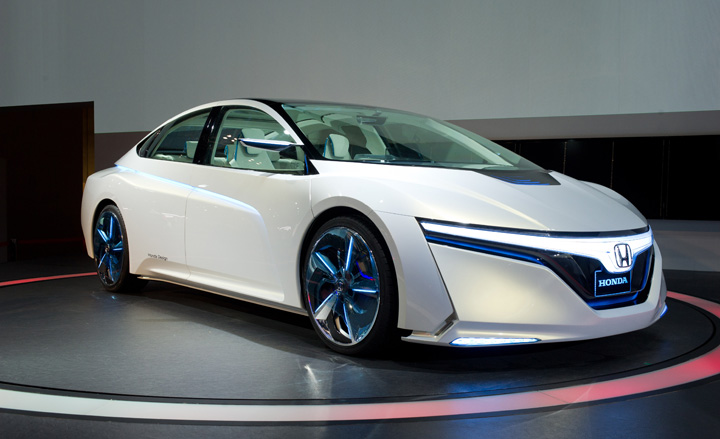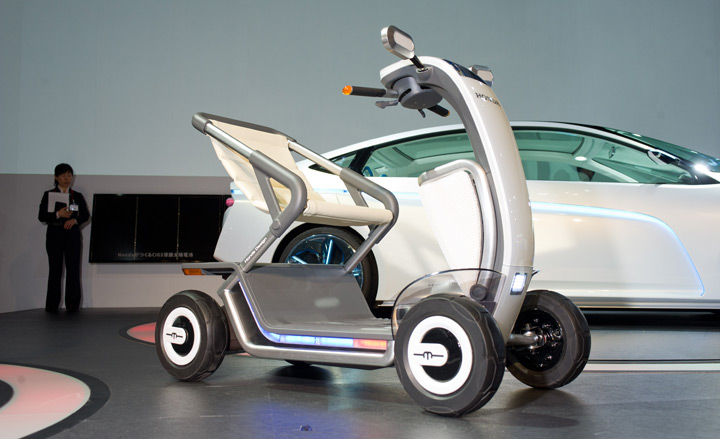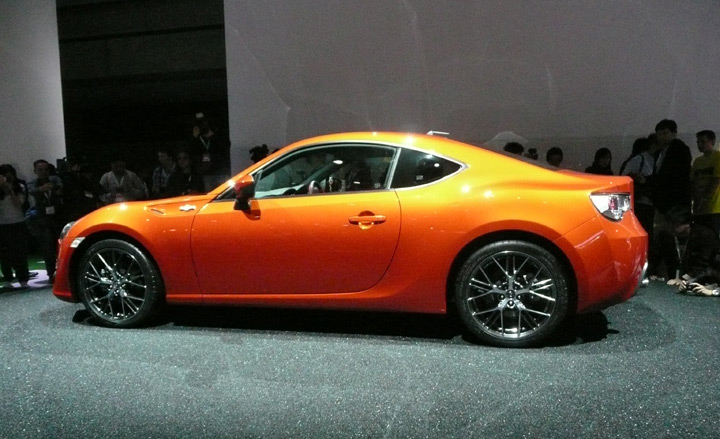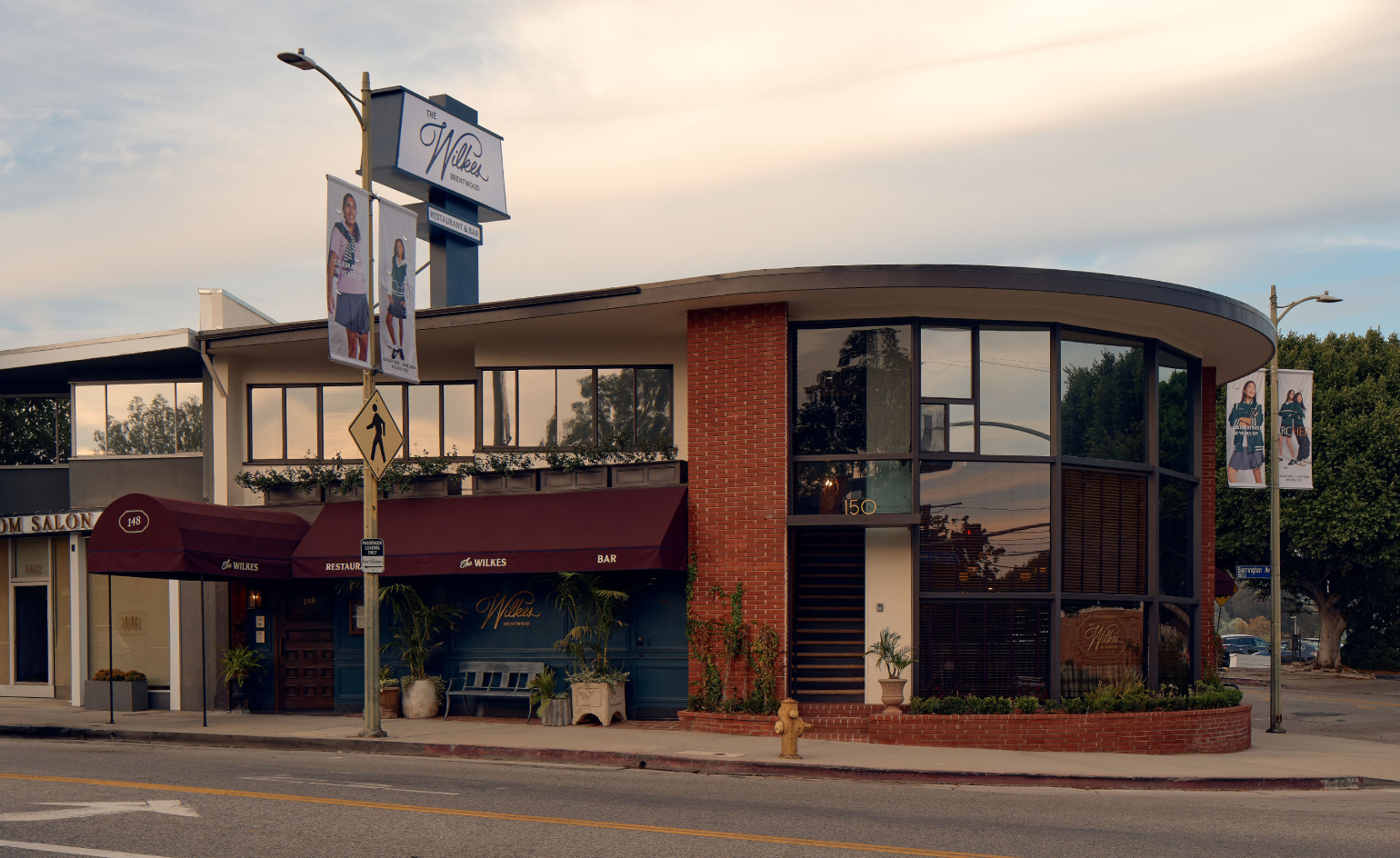Tokyo Motor Show 2011

After a bad year, the Japanese car industry is once again relying on what has always made it great - ingenuity and innovation - and the 42nd Tokyo Motor Show was a pure celebration of this.
Besides the effects of the earthquake and tsunami, the high yen has been hampering competitiveness on the international market. 'The yen is a huge handicap for exporters from Japan,' said Renault-Nissan chief executive Carlos Ghosn, further revealing that Nissan, the country's second largest carmaker, will have to gradually shift production to Thailand, China and Mexico to ease the effect of the strong currency.
Japan's largest car manufacturer Toyota only built 43 percent of its vehicles here last year, with Nissan and Honda under 30 percent. Worst still, according to the Japan Automobile Manufacturers Association, is the forecast that domestic car sales are to drop 14 percent to 4.25 million this year, compared with 7.77 million at its peak back in 1990.
Yet in complete contrast to the 2009 Tokyo show, this year's exhibition - at its new central city home in the Tokyo Big Sight - felt very optimistic with a number of products pointing confidently towards the future of mobility.
With the exception of a few cars unveiled by non-domestic brands, two general themes dominated the show - pod size urban commuters and pure sports cars - mostly with a focus on sustainability.
On the green front, Toyota is pushing ahead with hybrid technology, Nissan and Honda with electricity. Said Honda's chief executive Takanobu Ito at the show: 'Honda will set a goal to reduce CO2 emissions from our motorcycles, automobiles and power products around the world by 30 percent compared to 2000, and we will strive to attain this goal by 2020.'
The display on the stand reflected this commitment with seven new concept cars each covering one form of mobility - an electric super sports motorbike, a range of electric urban runabouts, a small electric sports car and one designed for long distance travel.
Receive our daily digest of inspiration, escapism and design stories from around the world direct to your inbox.
This being Tokyo - a compact megacity housing around 30 million - the venue felt apt for its display of small electric cars designed for urban commutes. Here, Nissan stole the show - the marque having initiated this trend back in 2005 with the first Pivo.
The good news is that the third and final Pivo, unveiled here, will go into production. Francois Bancon, head of their advanced design studio, told us that the design will remain almost the same when it is mass-produced in the next five years. The group, which includes the Renault and Infiniti brands, hopes to sell around 1.5 million electric vehicles by 2016, so cars like the Pivo are pivotal to this plan.
Kei car concepts were also featured at the show. Only sold domestically, these tax-saving small, boxy cars are perfect for city driving and, as with Honda's N-Concept, can also be timeless in their design. Sadly the commercial failure of the Nissan Cube in Europe has deterred others to risk a similar venture.
On the sports car front, Toyota's GT 86, designed to bring some much-needed sex appeal to the marque, was one of the stars of the show. Revealing a more contemporary design though, was the Honda EV-STER - an affordable electric sports car that harks back to the 1990s Beat. The firm confirmed the EV-STER would go into production in the next couple of years.
Much like Tokyo's exhibition pavilion stands, car design here is not polished and perfected - in many ways it sits completely on the opposite side of German car design. Instead it is a wonderful fusion of a thoroughly modern Japanese minimalist aesthetic and inventive concepts.
Where else would you have a child-size humanoid robot - Honda's new ASIMO - equipped with the world's first autonomous behaviour control technologies, as the star of a motor show?
Audi Samurai Blue
Based on the A1 but aimed strictly at the Japanese market, this is a concept that celebrates the world championship success of the country's ladies football team. It is likely to appear as a limited edition model
www.audi.com

Daihatsu D-X
The Daihatsu D-X is a compact multi-purpose two-seater concept that is powered by a two-cylinder turbocharged engine and is due to be produced soon
www.daihatsu.com

Daihatsu Pico
Daihatsu's Pico is an electric two-seat pod positioned between a light car and motorised bicycle
www.daihatsu.com

Daihatsu FC ShowCase
This mono-volume mini van runs on fuel-cell technology and is designed to be a mobile theatre to keep its occupants entertained on the road. The boxy car seats four and features giant wing doors, side-view cameras instead of mirrors, a touch panel steering wheel and a vast 60-inch television screen
www.daihatsu.com

Honda AC-X
Honda's AC-X (Advanced Cruiser Experience) is a hybrid car designed for long-distance travel. It offers two driving modes - Engine-Drive for aggressive and Automatic-Drive for autonomous driving. The front bumper, sideskirt, rear diffuser and front running lights adjust to express all this. Inside too the ambiance light changes to reflect how the car is moving. In autonomous mode, with a simple switch of a button, the steering wheel retracts, vanishing into the instrument panel for a spacious cockpit that allows the driver to relax and get on with other tasks. It may all sound far-fetched but Honda believes this way of driving could be the future of motoring
www.honda.com


Honda AC-X
Honda EV-STER
EV-STER is Honda's vision for a lightweight and affordable sports car for the future. This roadster concept is electrically powered using a small motor with 10 kWh batteries to send 78 horsepower to the rear wheel. Lead designer Ryo Sugiura said although he wasn't intentionally inspired by the Honda Beat of the 1990s when sketching this car, he feels the two have much in common. At the core of the concept though is its interior - a futuristic cabin featuring what the marque calls 'twin lever steering' (a kind of push-and-pull system) - to replace the conventional steering wheel. Honda creative director Yoshinori Asahi is confident that this kind of steering feels more natural and will be something that the firm will look into for the future. Honda plans to make this car, though it will be a little smaller to comply with Japan's tax regulations
www.honda.com


Honda EV-STER

Honda Micro Commuter
The Micro Commuter concept is Honda's vision for personal transport in dense cities. It acts much like a personal gadget that can be highly personalise by simply placing your mobile phone in the front slot. You can even customise the exterior graphics - a sort of personal gadget, a smartphone with wheels
www.honda.com


Honda Micro Commuter
Honda Motor Combo
The Motor Combo is a foldaway electric scooter, with a battery that can also be used to power personal gadgets
www.honda.com

Honda N-Concept
Honda showed four different variants on the N-Box kei car that will be sold only in Japan. The small mini-vans are pivotal to Honda's domestic growth and are expected to double company sales. Only 4m long, the N-Box cars' clever interior layout means the cabin is roomy at 2180mm, the reconfigurable rear compartment allowing for a generous boot space. The cars will be sold in Japan from Spring 2012
www.honda.com


Honda N-Concept

Honda RC-E
The RC-E is a powerful electric motorbike - the design follows the marque's classic RC series. The batteries are positioned in the traditional fuel tank and at the bottom of the vehicle
www.honda.com


Honda president Takanobu Ito and the company’s new humanoid ASIMO robot. Equipped with the world’s first autonomous behaviour control technologies, it was the star of Tokyo Motor show
Nissan LEAF Nismo Concept
This sports version of the electric Leaf features an aerodynamic body kit and revised bumpers. It showcases a bold new future for Nissan's Nismo performance arm
www.nissan.com

Nissan Pivo 3
Nissan's Pivo 3 is the marque's third take on the fantastically futuristic 2005 bubble car that saw its passengers spin 360-degrees around in the cabin. This final Pivo is more tamed as it is almost production ready and will be made in the next five years. Head of Nissan's advanced design studio in Japan Francois Bancon admitted that the design does take from anime and manga. 'This isn't on purpose but our designers are exposed to it all the time,' he told W* at the show. Pivo3 features Automated Valet Parking that will automatically drive, locate a parking space and park without driver assistance. It can also charge itself and return to its driver when called by smartphone. Bancon said this was pivotal in megacities like Tokyo where parking is strictly designated to tightly packed parking slots
www.nissan.com

Smart Fourtwo
Mercedes-Benz's young brand Smart showcased its Fourtwo but tailor made for Tokyo
www.smart.com

Subaru Advanced Tourer Concept
Subaru's Advanced Tourer Concept is a vision for what the next-generation Legacy will look like
www.subaru.com

Suzuki Fuel Cell Bike
Based on the same technology as the Crosscage fuel cell bike shown in 2007, the scooter now has a fuel cell which is air cooled, light and compact
www.suzuki.com

Suzuki Q
The Suzuki Q is a two-seat micro mobility pod positioned between a motorcycle and car. Only 2.5m long and with two seats in tandem configuration, this fun little mobility solution is ideal for dense cities
www.suzuki.com


Suzuki Q
Suzuki Regina
The Regina concept weighs only 730kg and boasts low carbon emissions of just 70g/km. It is Suzuki's vision of a next-generation global compact car
www.suzuki.com

Toyota Fun-Vii
The Toyota Fun-Vii (Fun-Vehicle interactive internet) is a smartphone on wheels designed to capture the attention of the younger generation who have lost interest in the automobile, says new chief of design Tokuo Fukuichi who is keen to find new ways of attracting this vital group. The overall design is very much aero-driven and the exterior and interior graphics can be highly personalised
www.toyota.com


Toyota Fun-Vii
Toyota GT-86
Toyota is returning to the sports car with the GT-86 to inject a little bit of excitement into a brand that is these days associated purely with the Prius. To be sold in 2012

Volkswagen Cross Coupe
The VW Cross Coupe concept was a genuine show surprise especially since it is unusual for a German carmaker to unveil a brand new show car in Tokyo. It represents where the marque aims to go aesthetically with its sports-utility cars. Much like Audi, VW cars have been criticised for looking much the same and group design director Walter de'Silva is keen to inject visual differentiation in the various segments

A writer and editor based in London, Nargess contributes to various international publications on all aspects of culture. She is editorial director on Voices, a US publication on wine, and has authored a few lifestyle books, including The Life Negroni.
-
 The Wilke is LA’s answer to the British pub
The Wilke is LA’s answer to the British pubIn the Brentwood Village enclave of Los Angeles, chef and restaurateur Dana Slatkin breathes new life into a storied building by one of Frank Gehry’s early mentors
-
 Top 10 gadgets of 2025, as chosen by technology editor Jonathan Bell
Top 10 gadgets of 2025, as chosen by technology editor Jonathan BellWhat were the most desirable launches of the last 12 months? We’ve checked the archives to bring you this list of the year’s ten best devices
-
 2026 will be all about style on screen. Here are some fashionable films to look out for
2026 will be all about style on screen. Here are some fashionable films to look out forFrom the return of Devil Wears Prada to a slew of stylish A24 projects, eight fashionable films to add to your watch list in 2026
-
 Wheels of the weird and wonderful: how the 2025 Japan Mobility Show met its brief
Wheels of the weird and wonderful: how the 2025 Japan Mobility Show met its briefWe bring you our selection of the ten most futuristic concepts and fascinating forthcoming machinery at Tokyo's Japan Mobility Show
-
 Tokyo Auto Salon 2025: custom cars and one-off creations from the Japanese home market
Tokyo Auto Salon 2025: custom cars and one-off creations from the Japanese home marketWhat began as a celebration of Japan's custom car culture is a now a major event for many of the country's biggest automakers. We round up the news from Tokyo Auto Salon 2025
-
 New Aston Martin Ginza showroom brings customer personalisation to life
New Aston Martin Ginza showroom brings customer personalisation to lifeAston Martin Ginza showroom is a two-storey space in The Peninsula Tokyo hotel and a new hub for the car maker
-
 The debut Japan Mobility Show saw the country’s carmakers preview the near future
The debut Japan Mobility Show saw the country’s carmakers preview the near futureThe 2023 Japan Mobility Show offered up a vast array of futuristic transportation, from concept sports cars to autonomous taxis, and eVTOL aircraft
-
 What we learned from Tokyo Motor Show 2019
What we learned from Tokyo Motor Show 2019With the axis of Asian automotive show influence long since moved from Japan to China in commercial terms — China is the biggest vehicle sales market in the world — the role of Tokyo’s biennial Motor Show has increasingly been to push Japanese vehicle makers’ high-tech creativity and advanced design skills
-
 What lies on the road ahead for Daimler and autonomous driving
What lies on the road ahead for Daimler and autonomous driving -
 Tokyo Motor Show 2017: the best new cars and concepts
Tokyo Motor Show 2017: the best new cars and concepts -
 Coast to coast: Brooks celebrates 150 years with a Tokyobike collaboration
Coast to coast: Brooks celebrates 150 years with a Tokyobike collaboration